| Click to make PDF of Guide! | Download latest spread prevention guide! |
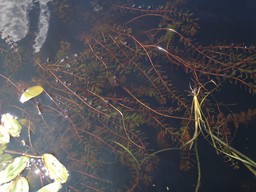 |
| Eurasian watermilfoil Credit: RIDEM K. DeGoosh |
Myriophyllum spicatum
History:
- Introduced to the United States in the 1940s
Characteristics:
- Rooted, submersed, perennial, aquatic plant
- Narrow, whitish stems grow to the water surface, extending 3-10 ft (1-3 m) or longer
- Forms dense beds
- Feather-like leaves with blunt ends commonly with 12 to 24 pairs of leaflets on each leaf
- Leaves are grouped in whorls of 3 - 6 leaves around stem
- Small flowers project 2-4 in (5-10 cm) above the water surface
Habitat:
- Lakes, ponds, slow-moving streams, reservoirs, and estuaries
- Depths greater than 3 ft (0.9 m)
- Tolerates brackish water
- Thrives in highly disturbed lake beds, lakes receiving nitrogen and phosphorus-laden runoff, and heavily used lakes
Known Distribution:
- Quebec and most of the U.S.
- Native to Europe and Asia
Impacts:
- Highly aggressive, nuisance species
- Can form dense mats that shade and crowd out native plants
- Degrades habitats used by fish for spawning and feeding
- Thick growth can impair recreational uses of waterways including boating, swimming, and fishing
- Yellow-green, matted vegetation on milfoil-dominated lakes creates perception that lake is “infested” or “dead"
- Control efforts cost millions of dollars annually; $500,000 per year in New York state alone
Common Vector(s):
Overland transport (e.g. boats, equipment)
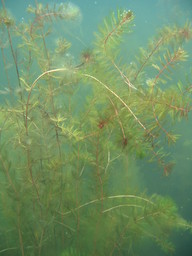 |
| Eurasian watermilfoil underwater |
| Eurasian watermilfoil leaves Credit: MEDEP-K.Hahnel |
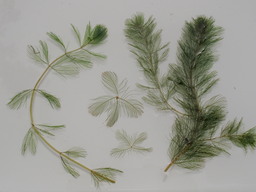 |
| Eurasian watermilfoil Credit: RIDEM - K.DeGoosh |
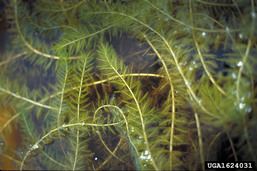 |
| Eurasian watermilfoil (Myriophyllum spicatum) Credit: Alison Fox, University of Florida |
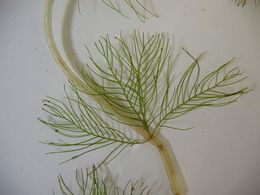 |
| Eurasian watermilfoil-leaves whorled around stem Credit: MEDEP - K.Hahnel |